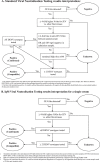Immunoglobulin M seroneutralization for improved confirmation of Japanese encephalitis virus infection in a flavivirus-endemic area
- PMID: 35593182
- PMCID: PMC9623734
- DOI: 10.1093/trstmh/trac036
Immunoglobulin M seroneutralization for improved confirmation of Japanese encephalitis virus infection in a flavivirus-endemic area
Abstract
Background: The mainstay of diagnostic confirmation of acute Japanese encephalitis (JE) involves detection of anti-JE virus (JEV) immunoglobulin M (IgM) by enzyme-linked immunosorbent assay (ELISA). Limitations in the specificity of this test are increasingly apparent with the introduction of JEV vaccinations and the endemicity of other cross-reactive flaviviruses. Virus neutralization testing (VNT) is considered the gold standard, but it is challenging to implement and interpret. We performed a pilot study to assess IgG depletion prior to VNT for detection of anti-JEV IgM neutralizing antibodies (IgM-VNT) as compared with standard VNT.
Methods: We evaluated IgM-VNT in paired sera from anti-JEV IgM ELISA-positive patients (JE n=35) and negative controls of healthy flavivirus-naïve (n=10) as well as confirmed dengue (n=12) and Zika virus (n=4) patient sera. IgM-VNT was subsequently performed on single sera from additional JE patients (n=76).
Results: Anti-JEV IgG was detectable in admission serum of 58% of JE patients. The positive, negative and overall percentage agreement of IgM-VNT as compared with standard VNT was 100%. A total of 12/14 (86%) patient samples were unclassified by VNT and, with sufficient sample available for IgG depletion and IgG ELISA confirming depletion, were classified by IgM-VNT. IgM-VNT enabled JE case classification in 72/76 (95%) patients for whom only a single sample was available.
Conclusions: The novel approach has been readily adapted for high-throughput testing of single patient samples and it holds promise for incorporation into algorithms for use in reference centres.
Keywords: diagnostics, flavivirus, Laos; neglected tropical disease; neurological infection, seroneutralization.
© The Author(s) 2022. Published by Oxford University Press on behalf of Royal Society of Tropical Medicine and Hygiene.
Figures
Similar articles
-
Analysis of cross-reactivity between flaviviruses with sera of patients with Japanese encephalitis showed the importance of neutralization tests for the diagnosis of Japanese encephalitis.J Infect Chemother. 2019 Oct;25(10):786-790. doi: 10.1016/j.jiac.2019.04.003. Epub 2019 May 16. J Infect Chemother. 2019. PMID: 31105002
-
Analysis of cross-reactivity among flaviviruses using sera of patients with dengue showed the importance of neutralization tests with paired serum samples for the correct interpretations of serological test results for dengue.J Infect Chemother. 2023 May;29(5):469-474. doi: 10.1016/j.jiac.2023.01.015. Epub 2023 Jan 24. J Infect Chemother. 2023. PMID: 36702208
-
Detection of Japanese encephalitis virus immunoglobulin M antibodies in serum by antibody capture radioimmunoassay.J Clin Microbiol. 1982 Mar;15(3):353-61. doi: 10.1128/jcm.15.3.353-361.1982. J Clin Microbiol. 1982. PMID: 6281305 Free PMC article.
-
Serological cross-reactivity among common flaviviruses.Front Cell Infect Microbiol. 2022 Sep 15;12:975398. doi: 10.3389/fcimb.2022.975398. eCollection 2022. Front Cell Infect Microbiol. 2022. PMID: 36189346 Free PMC article. Review.
-
Biomarkers in Japanese encephalitis: a review.Biomed Res Int. 2013;2013:591290. doi: 10.1155/2013/591290. Epub 2013 Dec 18. Biomed Res Int. 2013. PMID: 24455705 Free PMC article. Review.
Cited by
-
Deep Proteomics Network and Machine Learning Analysis of Human Cerebrospinal Fluid in Japanese Encephalitis Virus Infection.J Proteome Res. 2023 Jun 2;22(6):1614-1629. doi: 10.1021/acs.jproteome.2c00563. Epub 2023 May 23. J Proteome Res. 2023. PMID: 37219084 Free PMC article.
-
Zika virus-specific and orthoflavivirus-cross-reactive IgGs correlate with Zika virus seroneutralization depending on prior dengue virus infection.PLoS Negl Trop Dis. 2025 Jul 9;19(7):e0013274. doi: 10.1371/journal.pntd.0013274. eCollection 2025 Jul. PLoS Negl Trop Dis. 2025. PMID: 40632785 Free PMC article.
References
-
- World Health Organization . Japanese encephalitis vaccines: WHO position paper, February 2015–recommendations. Vaccine. 2016;34(3):302–3. - PubMed
-
- Pearce JC, Learoyd TP, Langendorf BJet al. . Japanese encephalitis: the vectors, ecology and potential for expansion. J Travel Med. 2018;25(Suppl 1):S16–26. - PubMed
-
- Simon-Loriere E, Faye O, Prot Met al. . Autochthonous Japanese encephalitis with yellow fever coinfection in Africa. N Engl J Med. 2017;376(15):1483–5. - PubMed
Publication types
MeSH terms
Substances
Grants and funding
LinkOut - more resources
Full Text Sources
Medical



